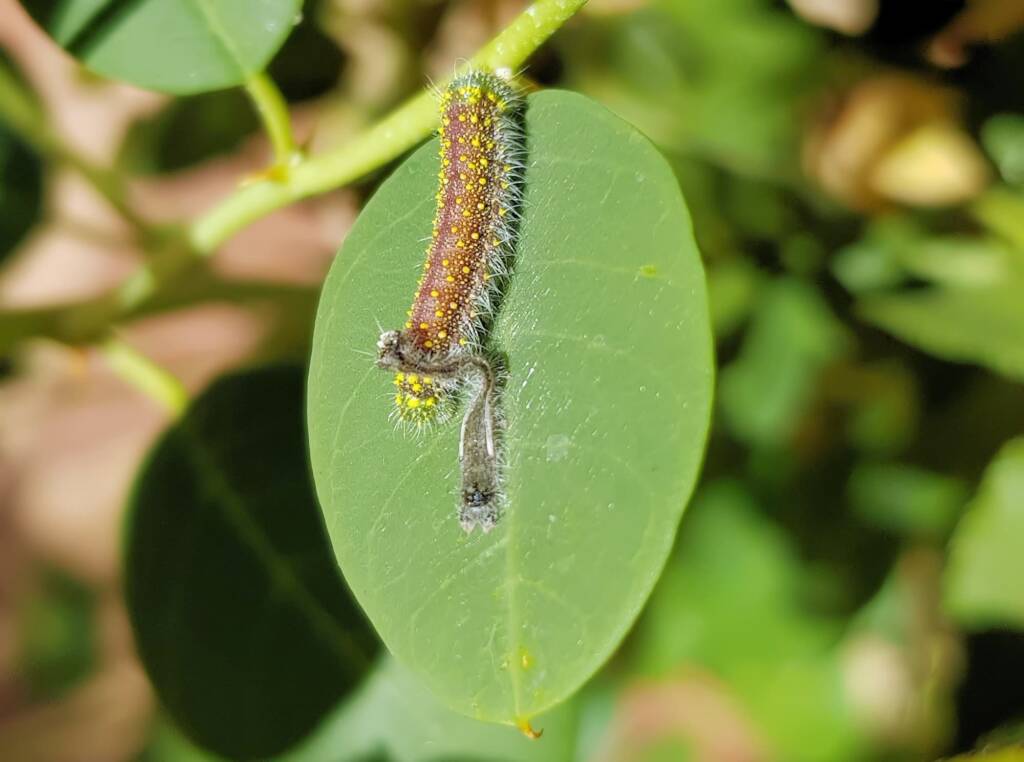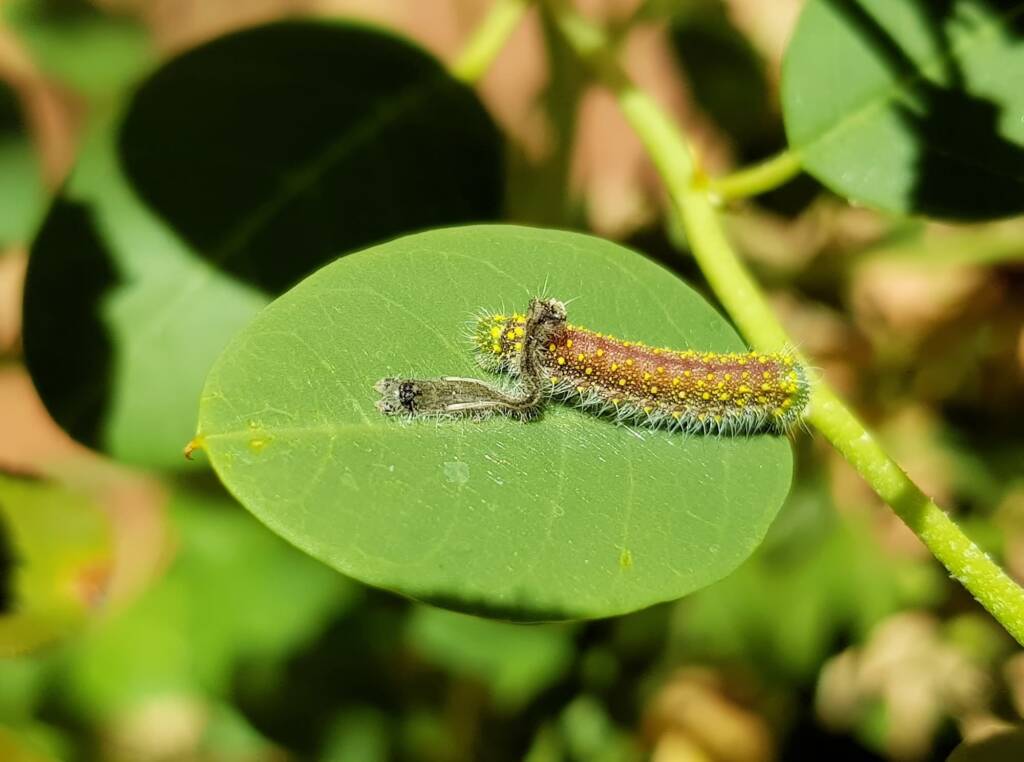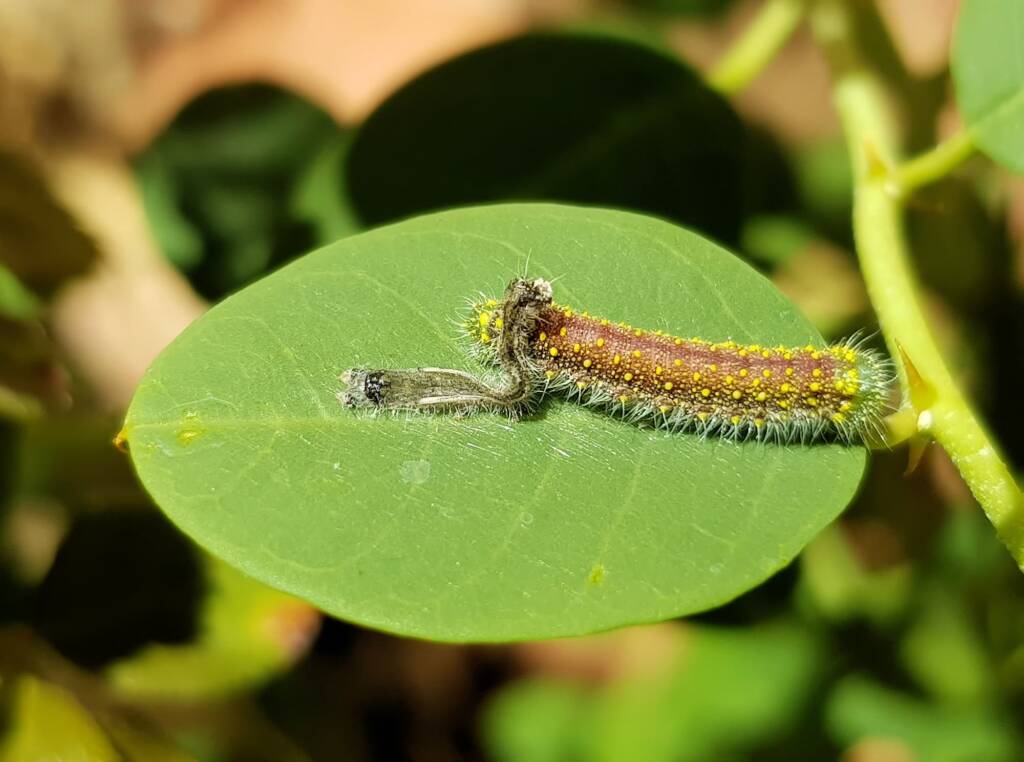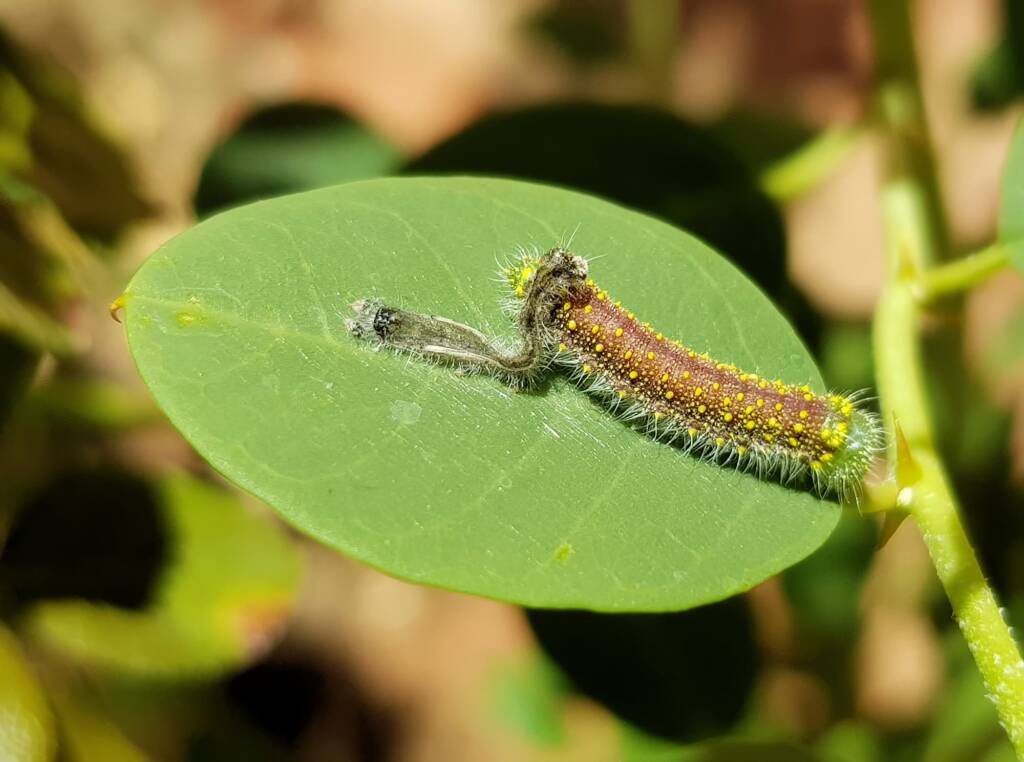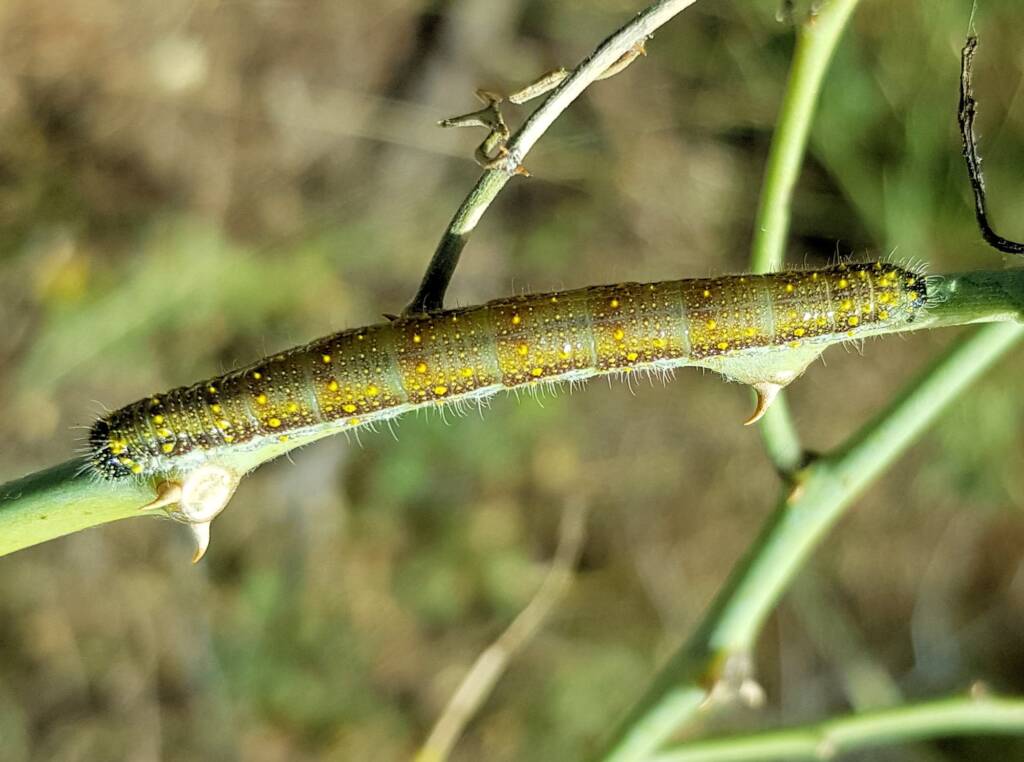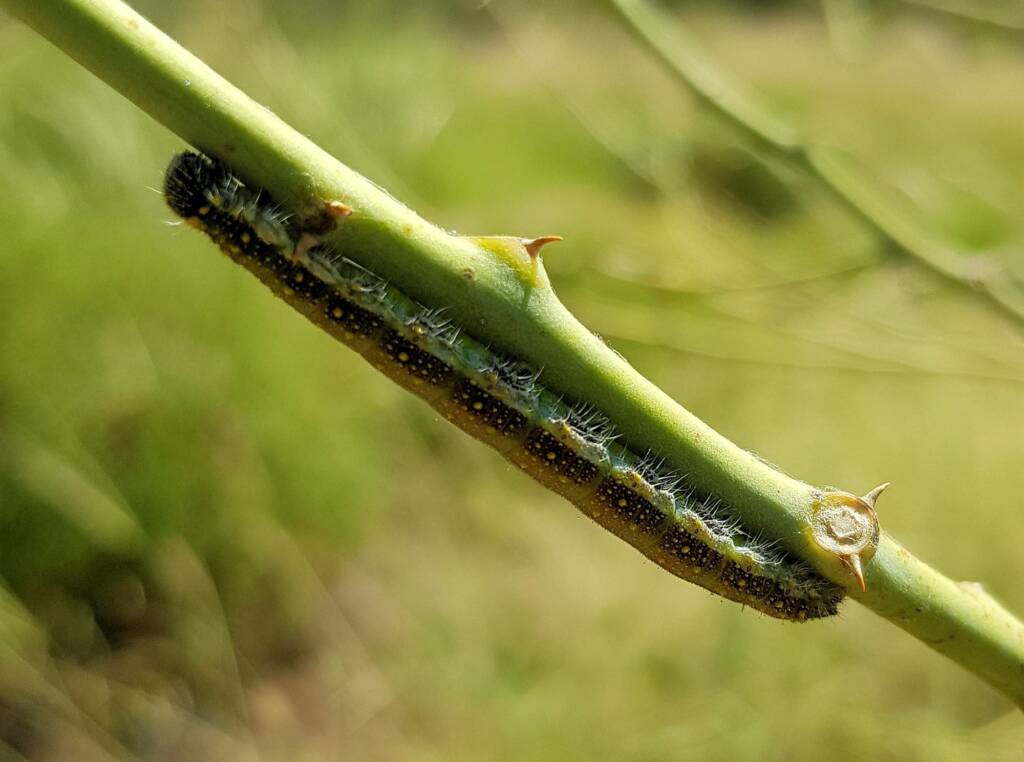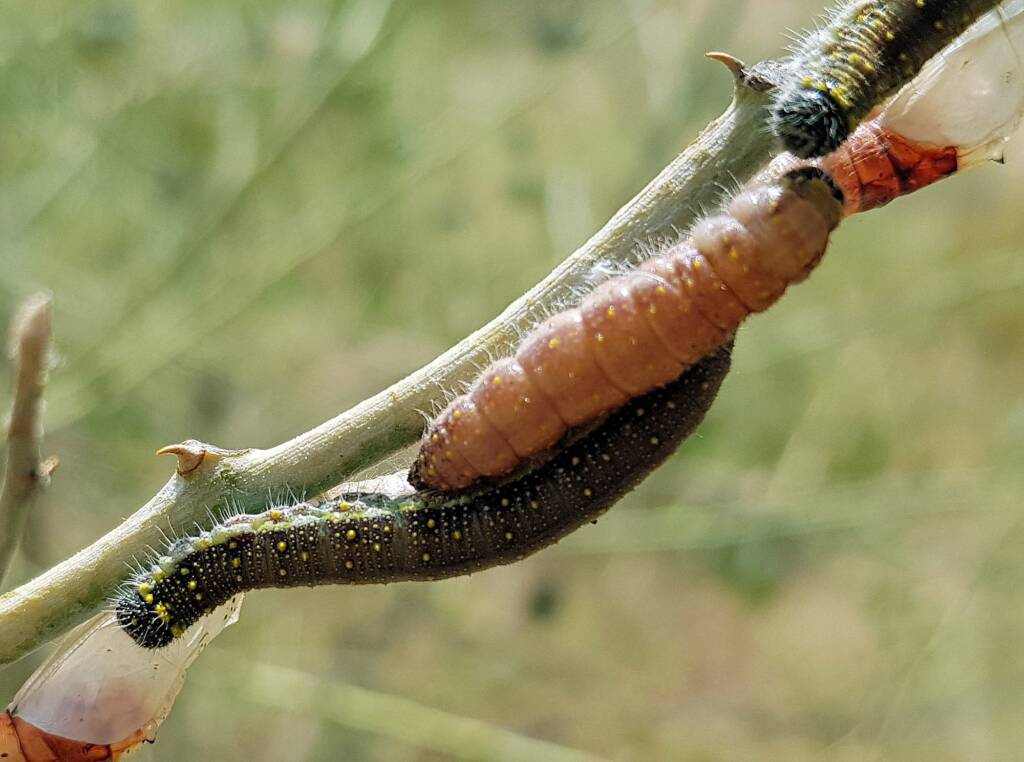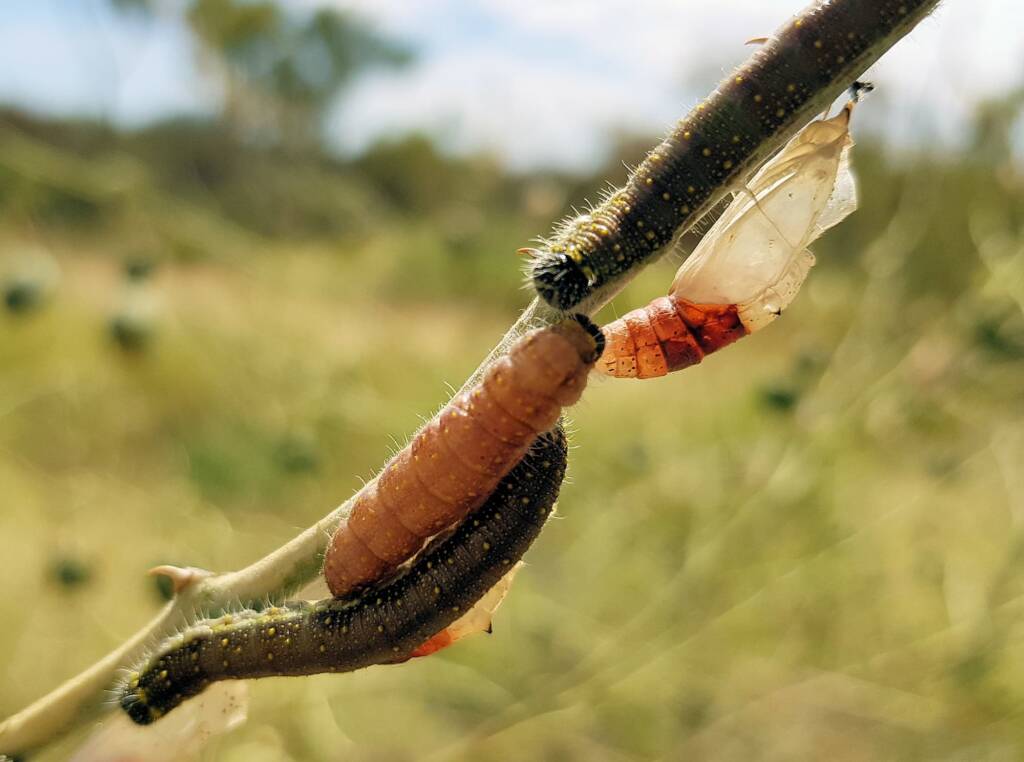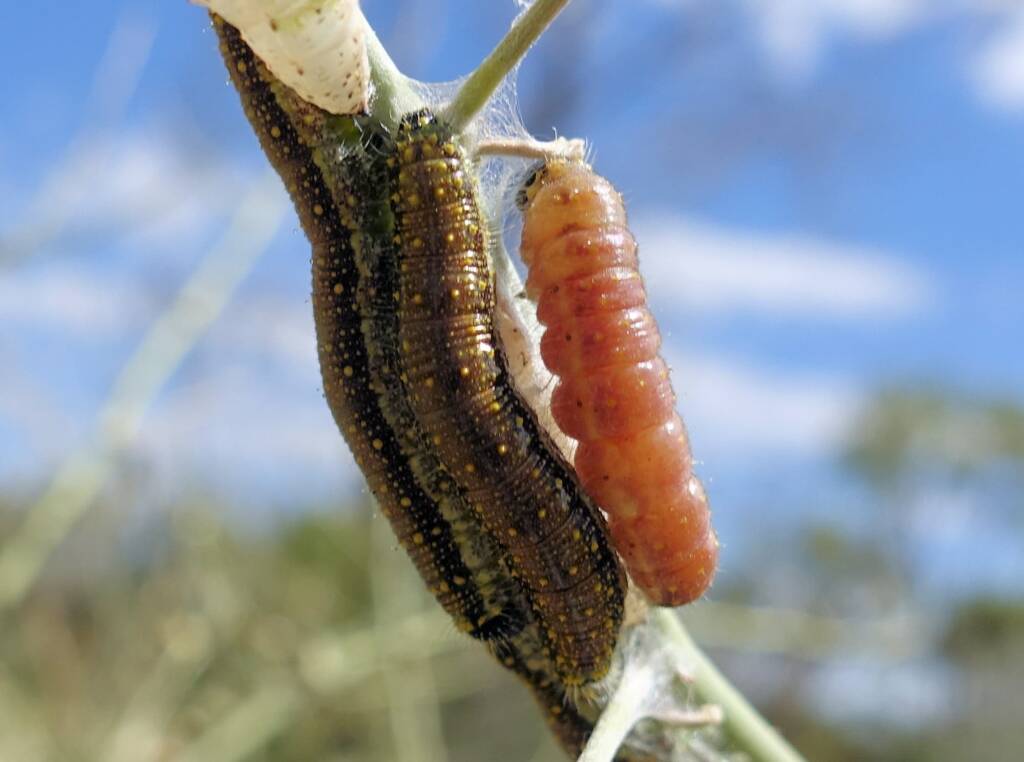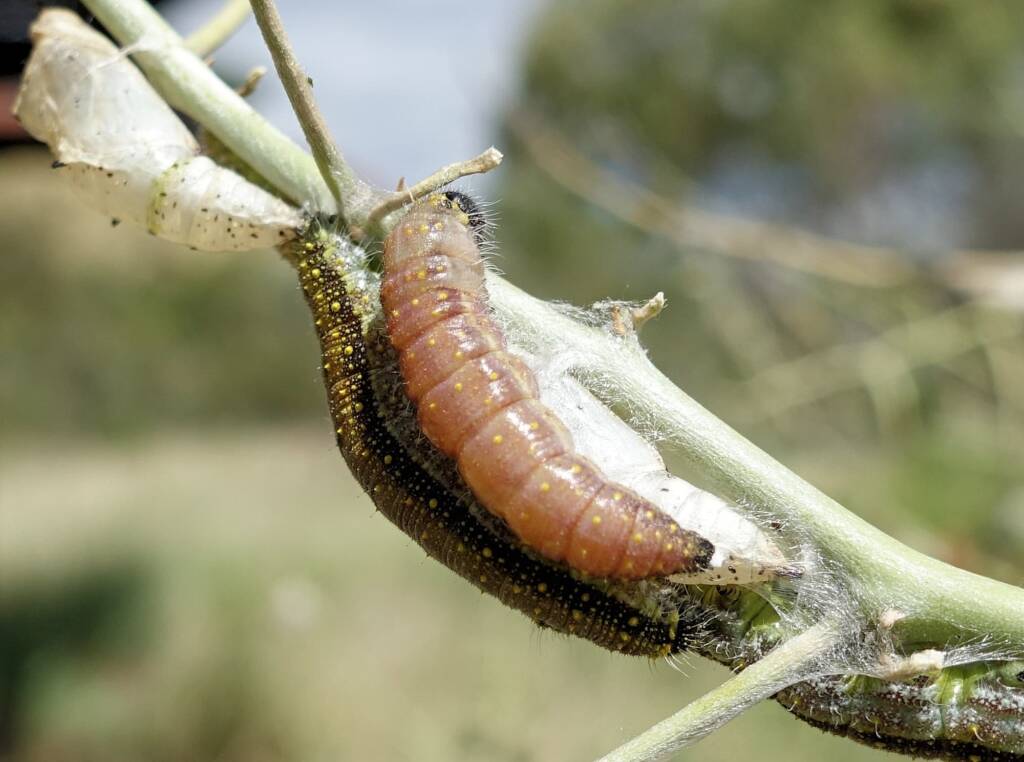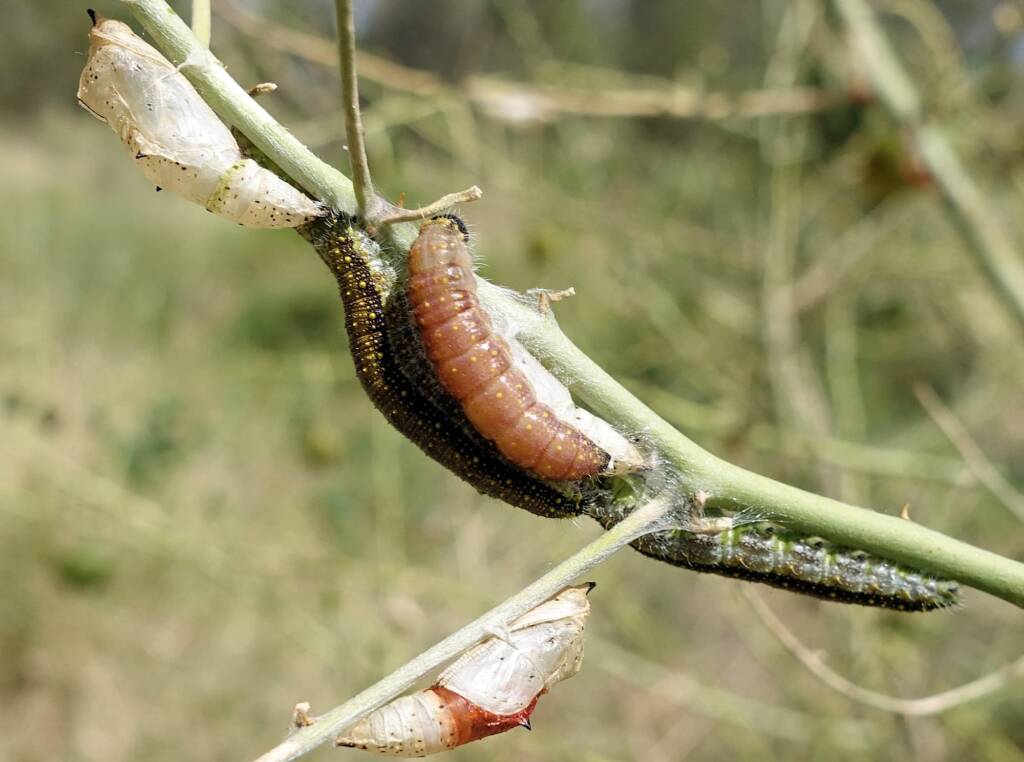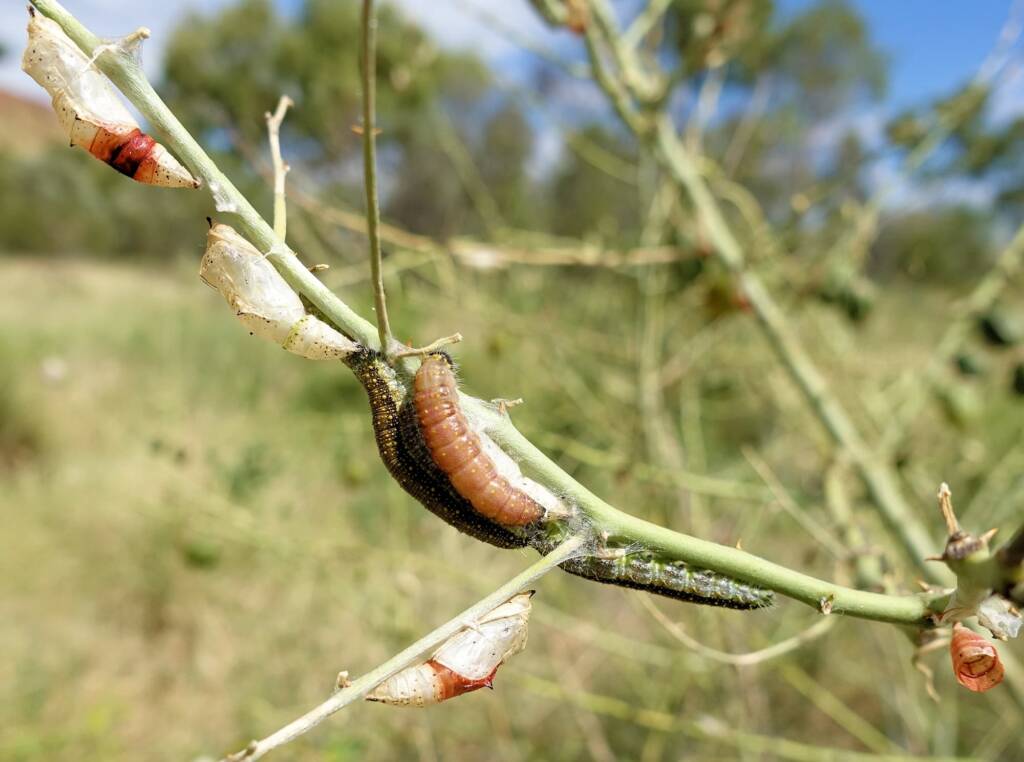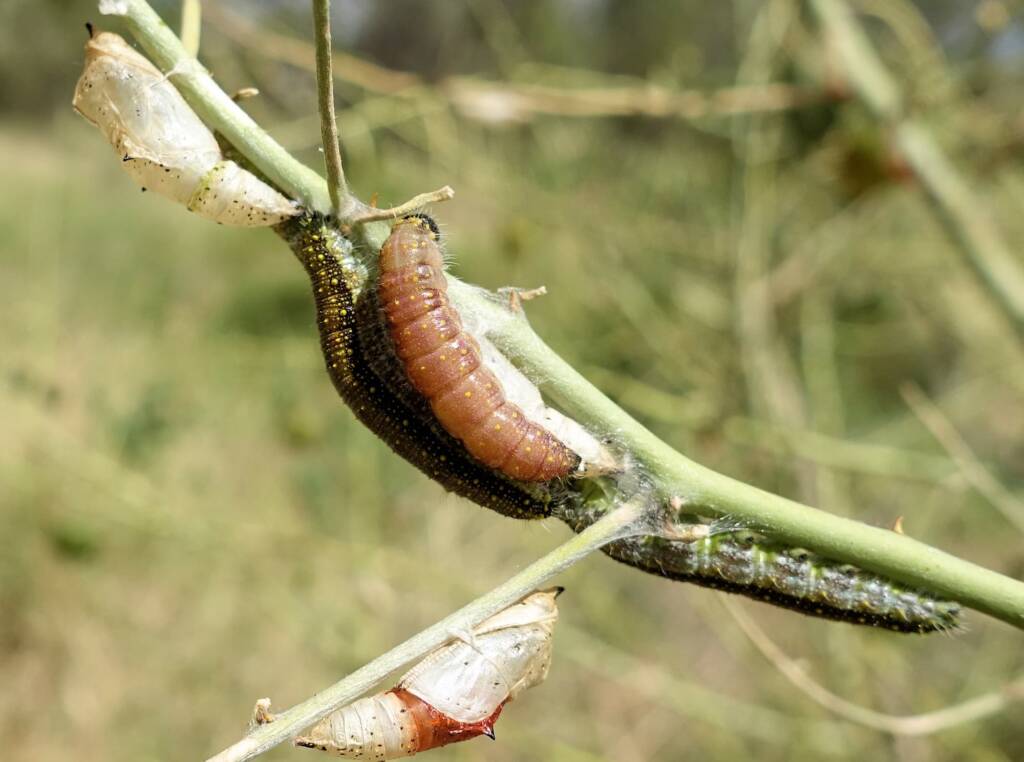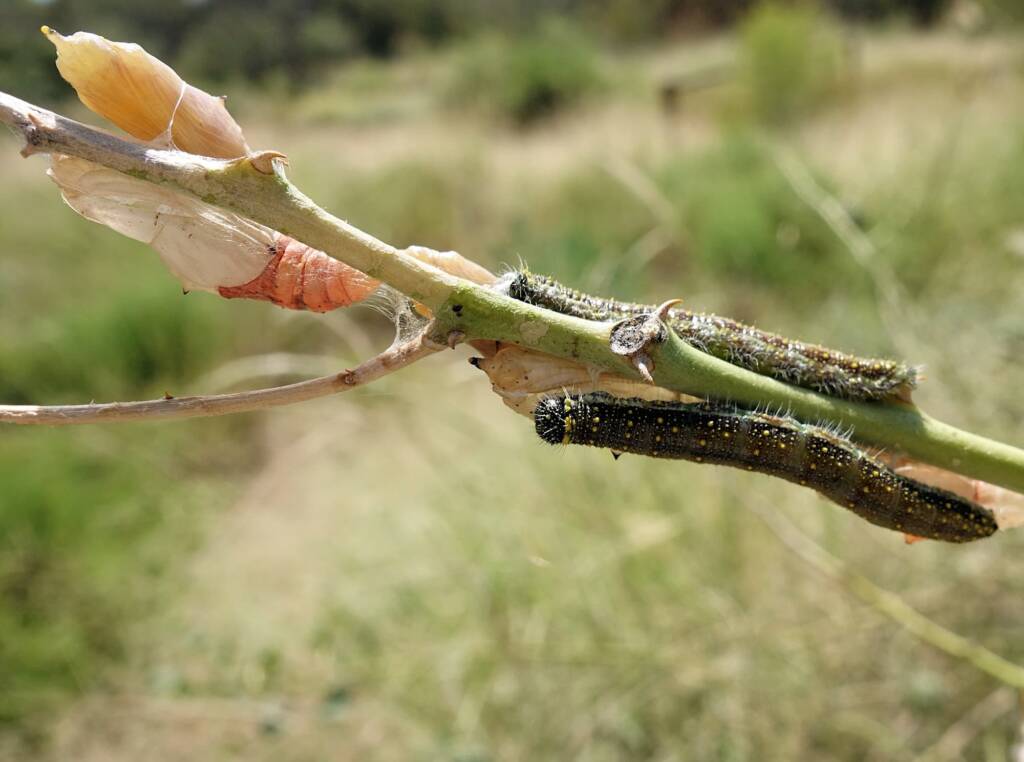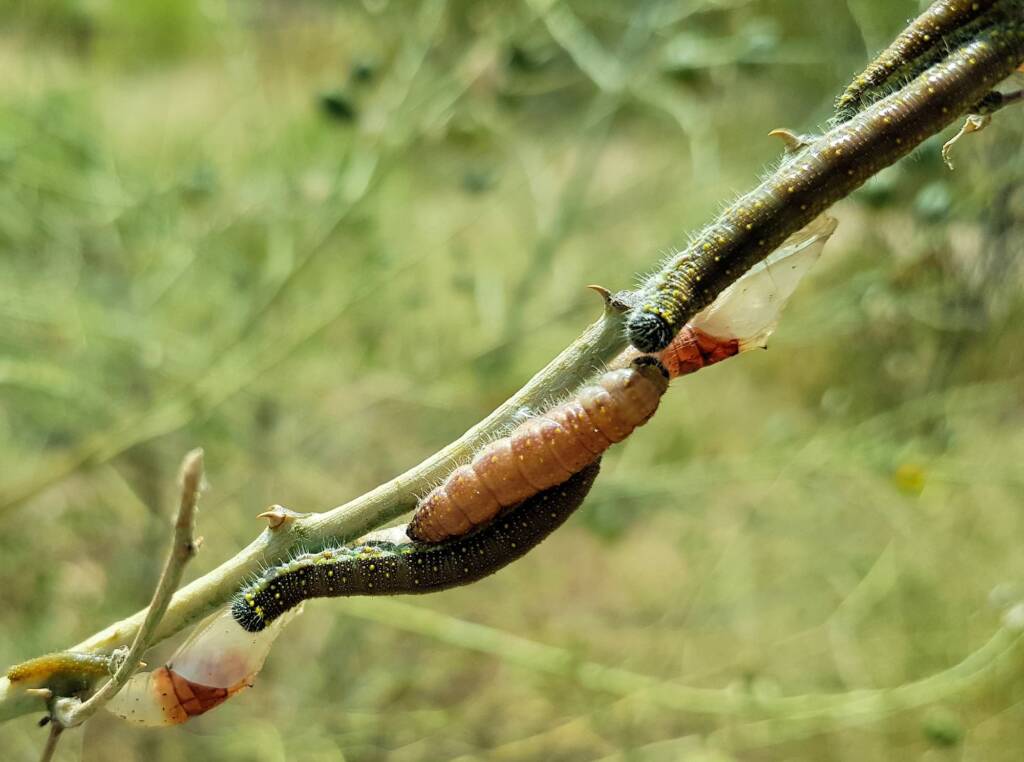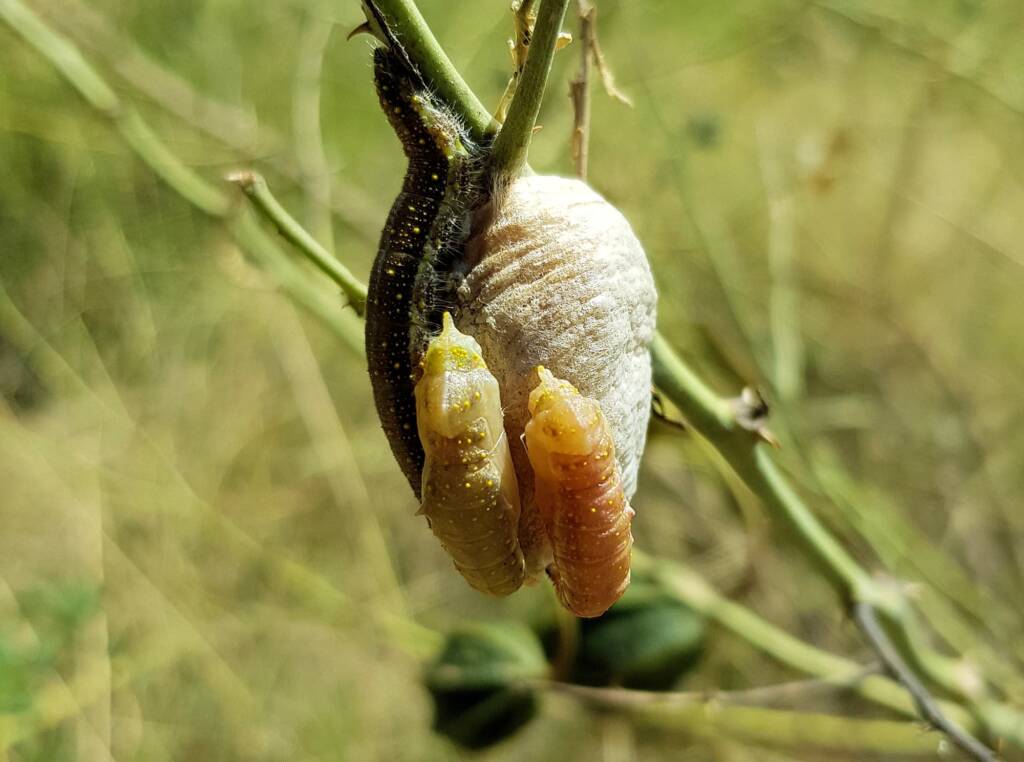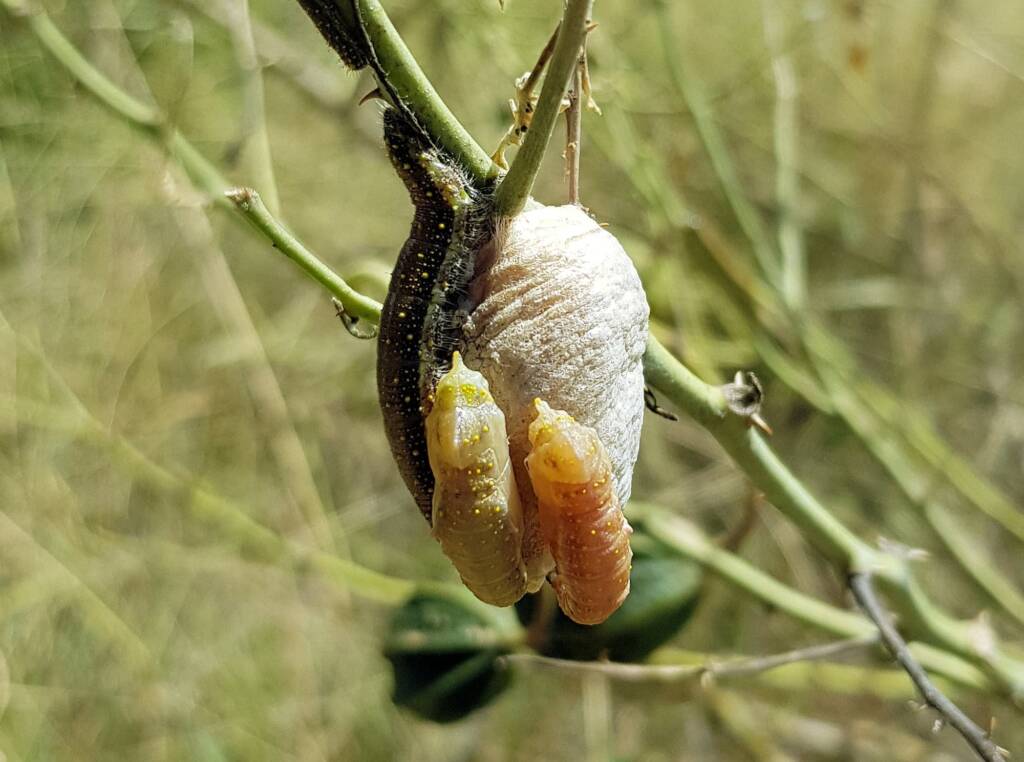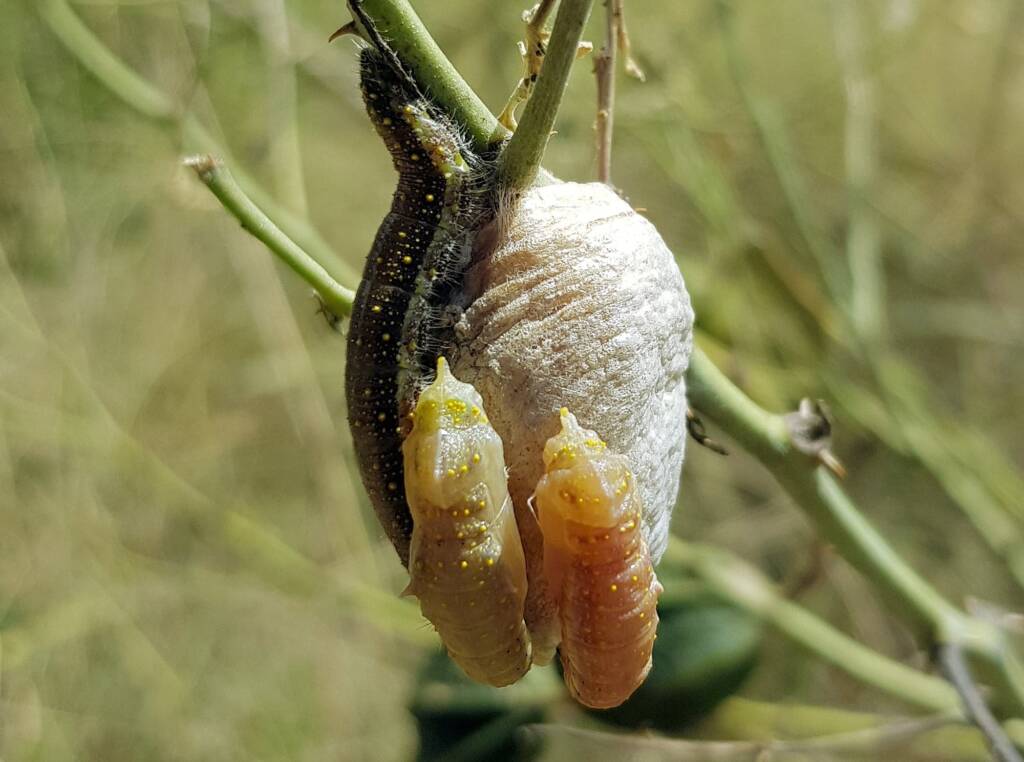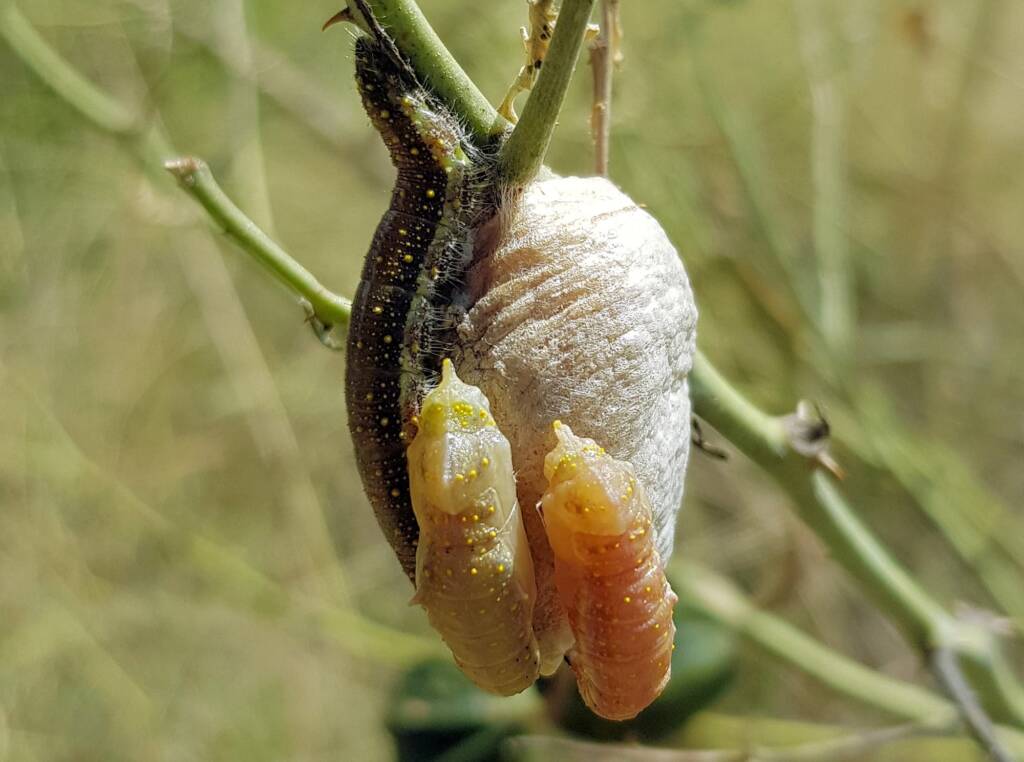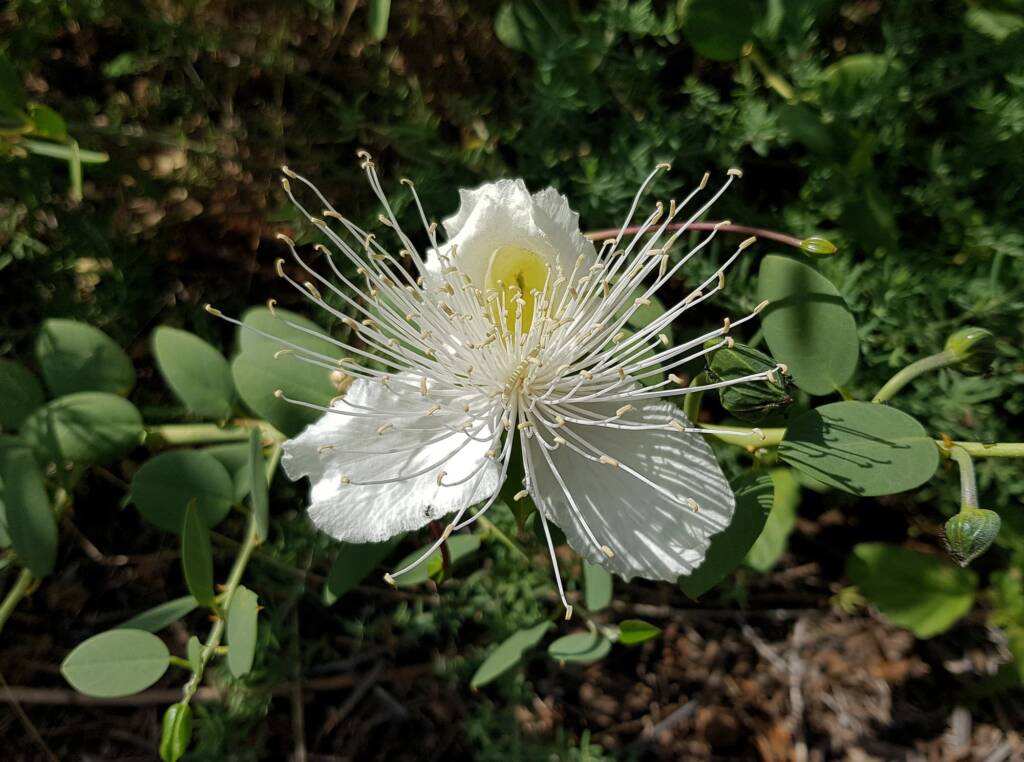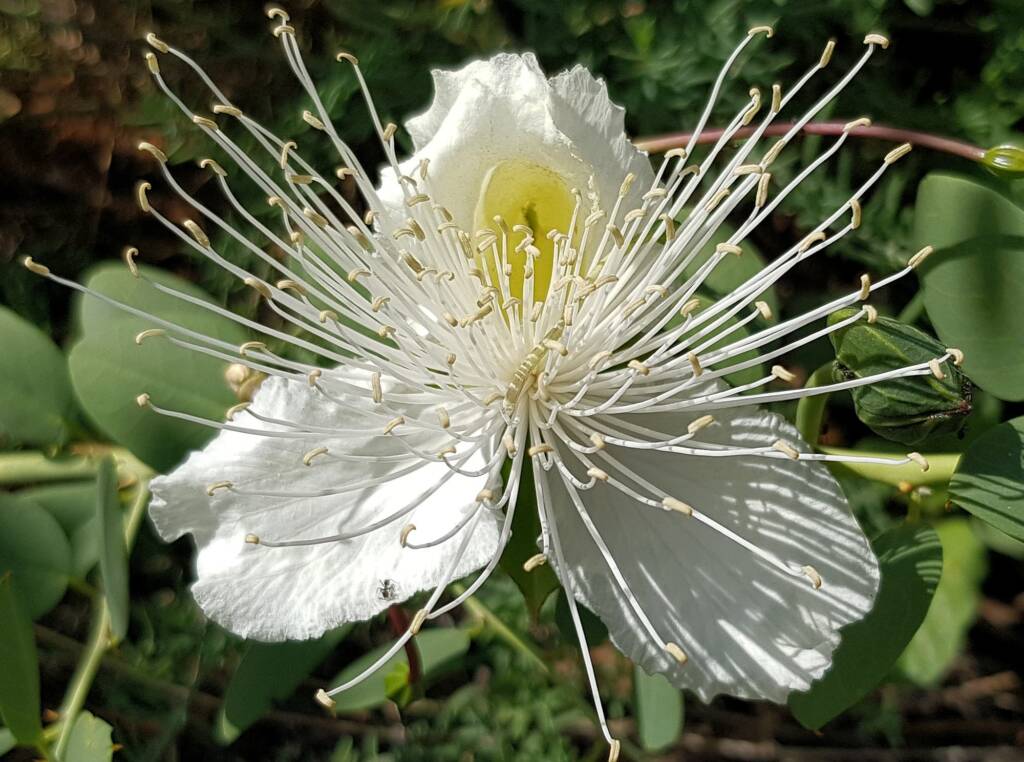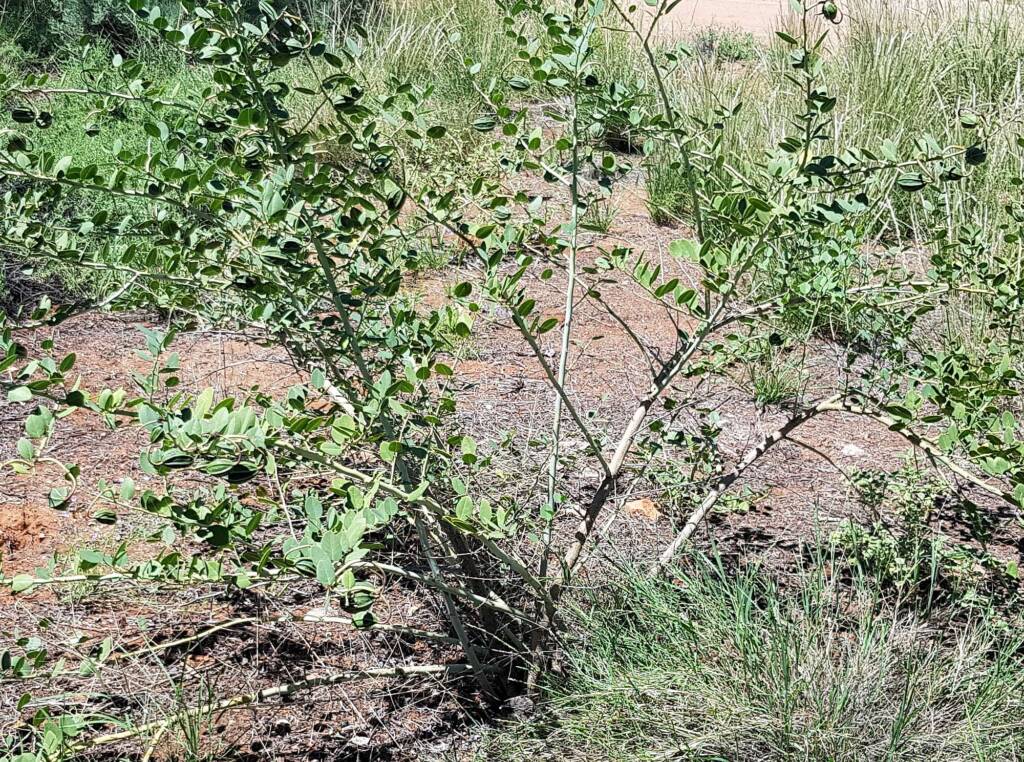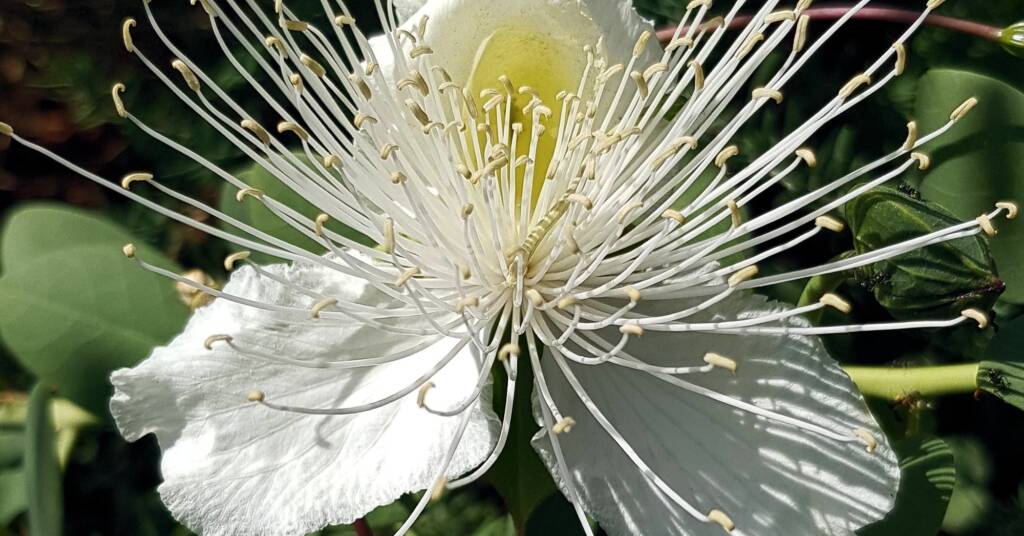Caper White ButterflyCaper White Butterfly & Caper Bush Caper White Caterpillar and Instar Eggs of the Caper White Butterfly Caper White Butterfly Metamorphosis
The Caper White Butterfly (Belenois java teutonia) goes through four stages in its life cycle, starting from the ovum or egg, larva or caterpillar, pupa or chrysalis, and finally the adult (having emerged from the chrysalis as the recognised butterfly).
The caterpillar after hatching from an egg, goes through five instar stages. An instar is a larval development stage ie the stage following larval skin moult. The final part of the life cycle, is when the larva having finished its growth development, enters the pre-pupal larval stage, where it forms into the pupa within the final larval skin. It is from this final moult, when the butterfly emerges from the chrysalis, leaving the pupa behind.
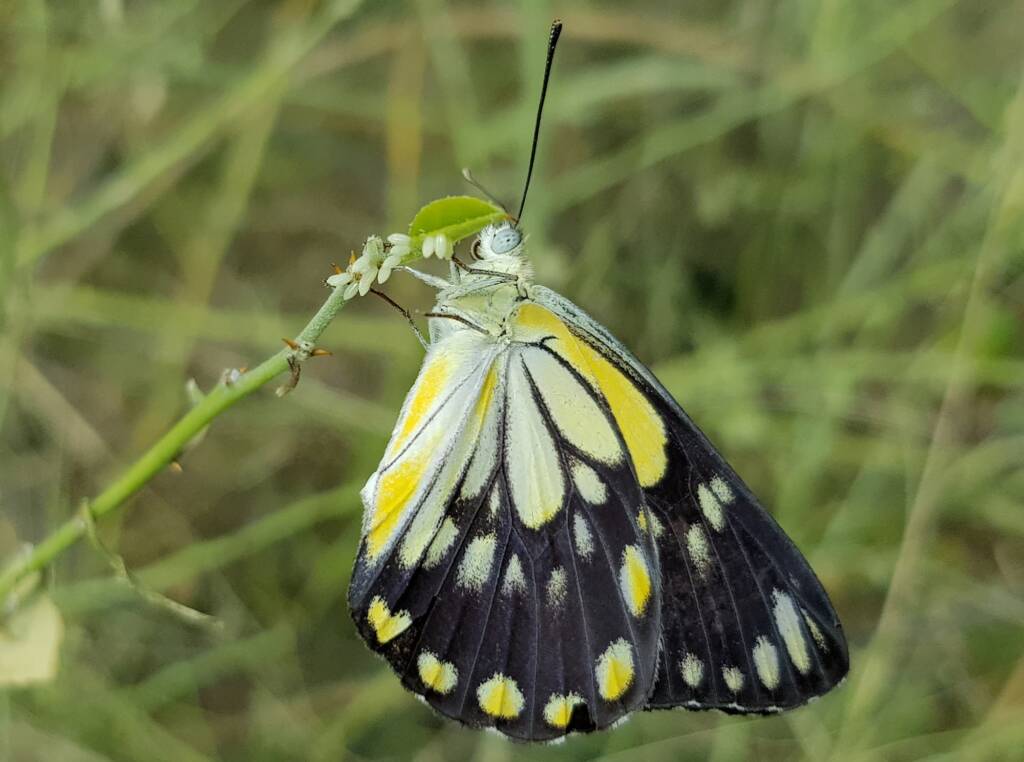
The following image show the Caper White Butterfly (Belenois java teutonia) laying its eggs on the Caper Bush (Capparis spinosa var. nummularia). This particular caper bush where they are laying the eggs, had already gone through cycles of previous generations of caterpillars eating the foliage off the plant and also stripping and consuming the edible bark. In this instance, with so few leaves on the bush, it will be highly unlikely for the caterpillars that hatch from these eggs to successfully go through the instar stages. Most likely they will either die from starvation or be eaten by predators.
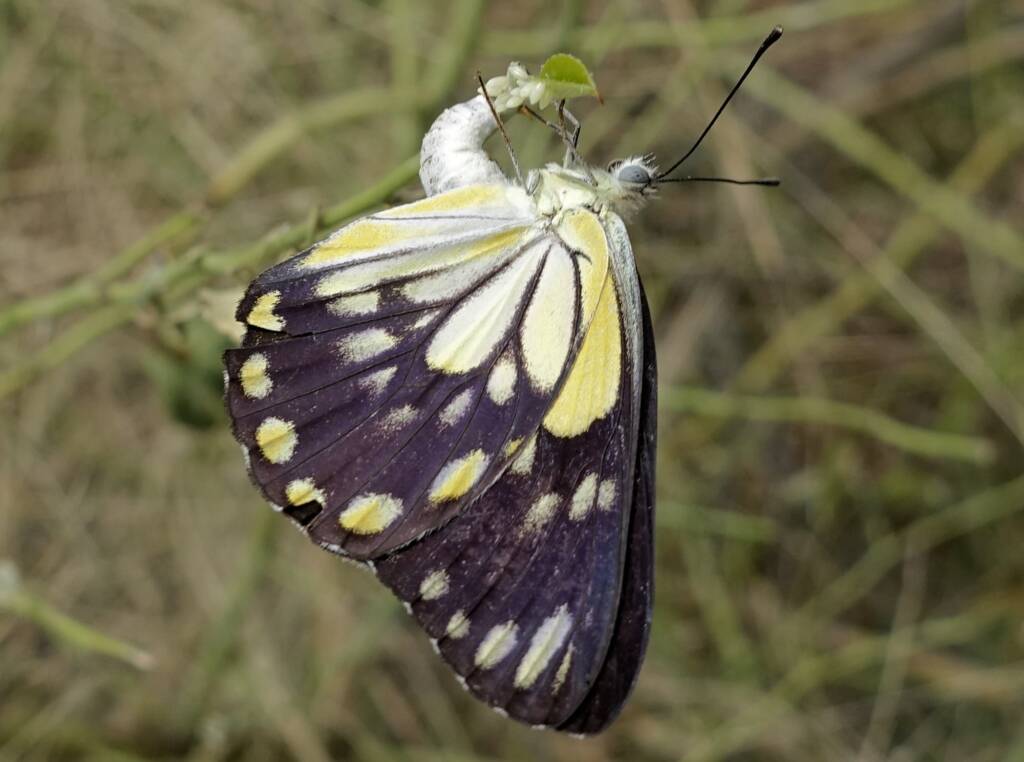
The caterpillars will eat for about three weeks, as it goes through the larval development stages (instar), growing to a length of approximately 3 centimetres, before pupating.
In the first instar of the Caper White Butterfly, the caterpillar have a pale cream body that is sparsely covered with long hairs, and a shiny black head. The body will start to have a yellow tinge, darkening in colour as it eats and grows.
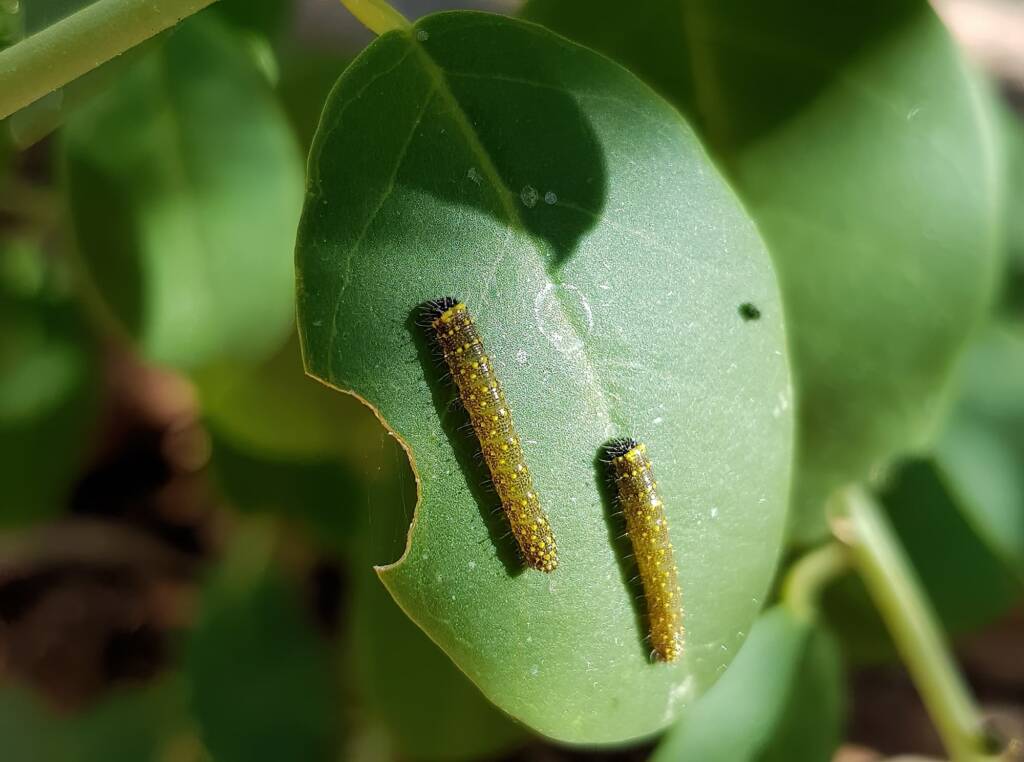
As the caterpillar grows, it will need to shed (moult) the skin. Each larval skin moult leads into the next instar stage. In the following photo you can see the skin of the head falling away, as the caterpillar moults (the previous skin still hanging from the tail end of the caterpillar).
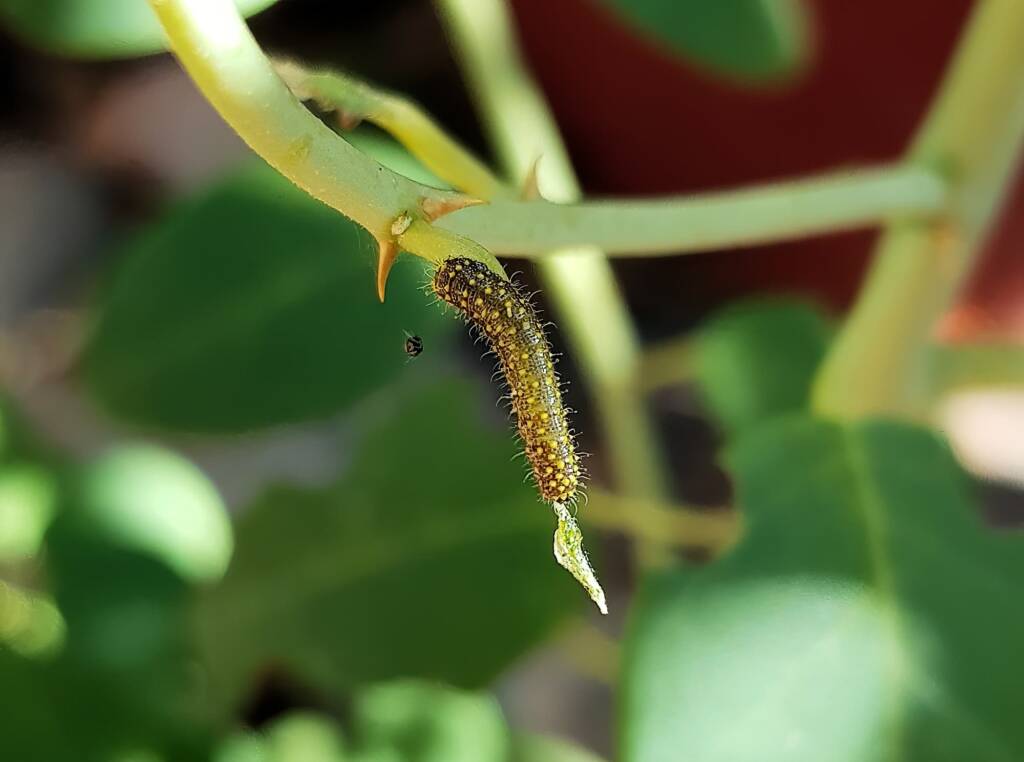
In the following photos of the larval development stage (instar) of the caterpillar (Belenois java teutonia), you can see it has shed its old skin.
In the final instar, the mature caterpillar is dark brown-green, with pale dots and raised yellow spots. There is a fringe of long white hairs running along each side of the caterpillar’s body. The head is black, with a pale ‘V’ shaped mark and yellow dots.
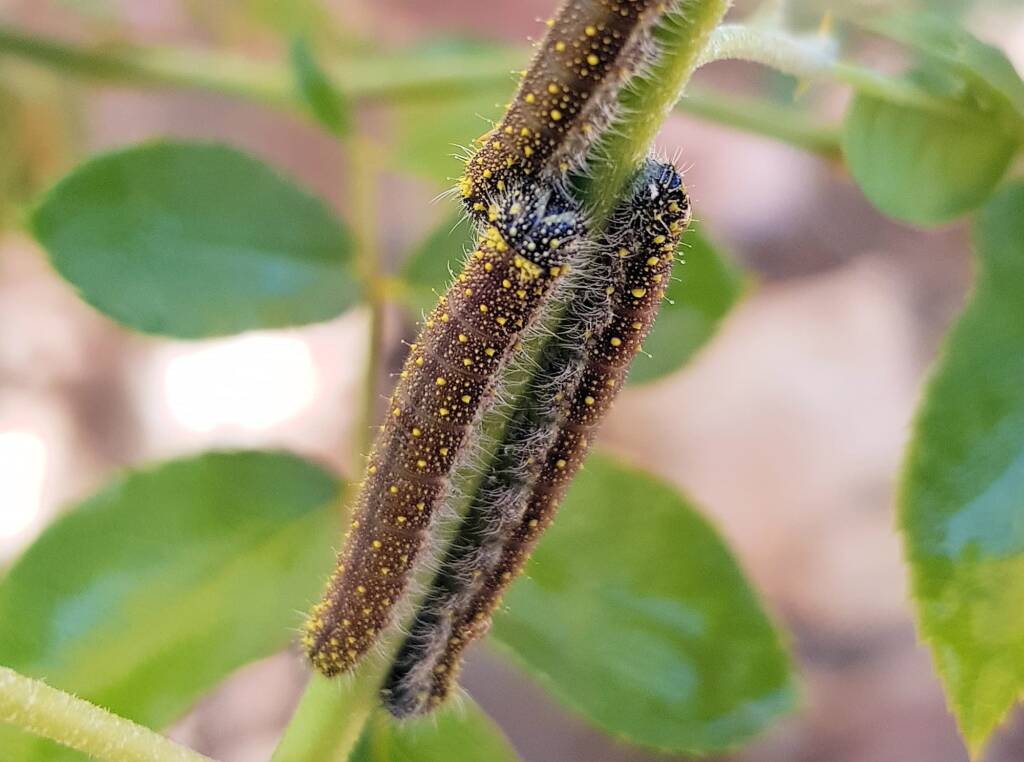
Caper White Butterflies are migratory butterfly and often you will see multiple broods of caterpillars that have hatched from eggs laid by the passing female butterflies. In the following photos, you can see various larval development stages (instars) of the Belenois java teutonia. Some most likely having hatched from eggs laid by different female Caper White Butterflies over time.
The caterpillars of the Caper White are also a gregarious species, feeding together, and then will often pupate alongside each other. Often when one starts to pupate the others will also commence pupation, even if they haven’t finished their final instar growth. Hence, one of the reason for variability in adult sizes.
The following photos show the pupae forming attached to an ootheca.
An ootheca is a type of egg mass created by a variety of species that include certain types of mantises, and cockroaches.caterpillars on this
These pupae have just formed and as such haven’t harden with the final spotted colouration.
As the larva finishes it growth development, it enters the pre-pupal larval stage, where it forms into the pupa within the final larval skin which it will moult leaving the pupa behind.
This final stage when the caterpillar pupates, is always on the plant it has been feeding on.
The pupa (also known as the chrysalis), is white in colour with black markings, although there are variations in colour as can be seen in the empty chrysalis cases in the following photo.
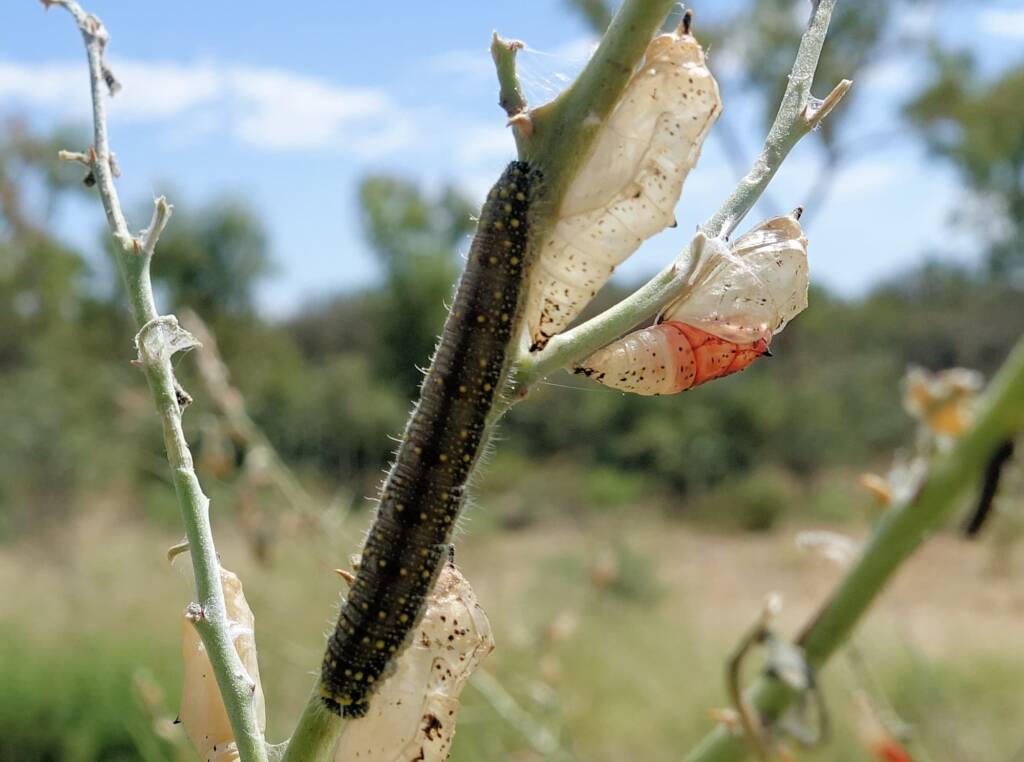
The chrysalis from which the Caper White Butterfly emerges are approximately 2.5 centimetres in length, although as available food diminishes, the caterpillars will be smaller then average prior to pupation. This results in smaller chrysalis.
In the following image, the newly emerged females are met by the awaiting males for copulation.
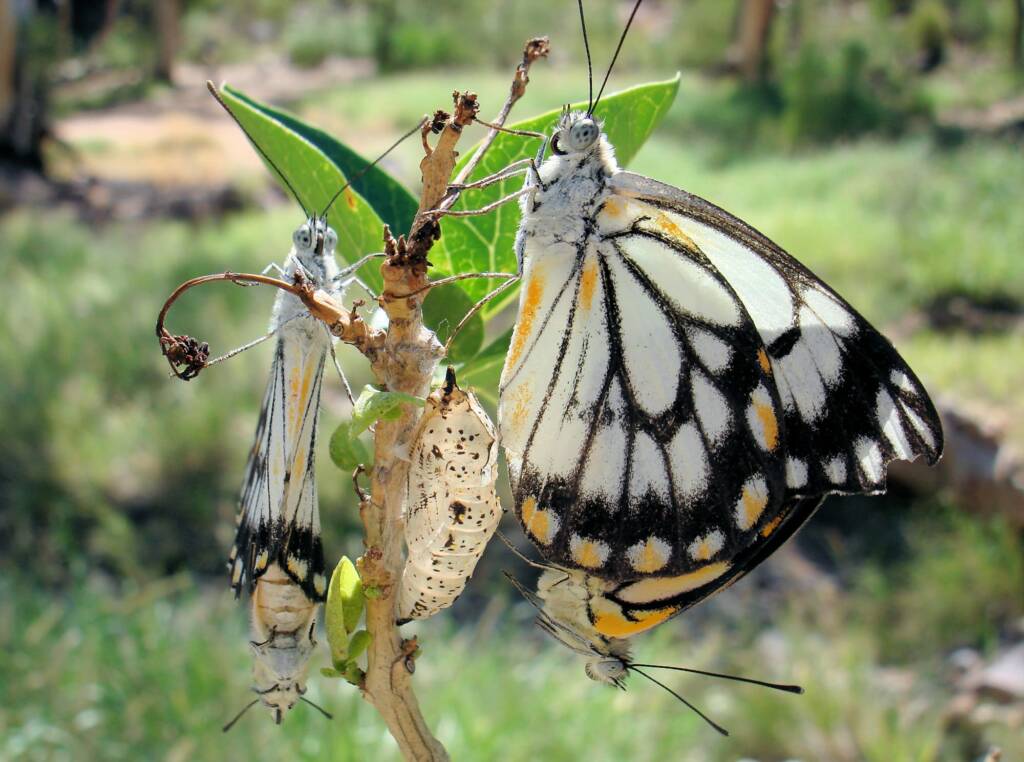
The caterpillar of the Caper White Butterfly eat only plants that are in the caper family (Capparis spp). In Central Australia, you can often see them on the Wild Passionfruit, such as Capparis spinosa var. nummularia. They can sometimes appear in such numbers that the caterpillar will strip the plant of all the edible leaves, although in most cases, the plant appears to recover.
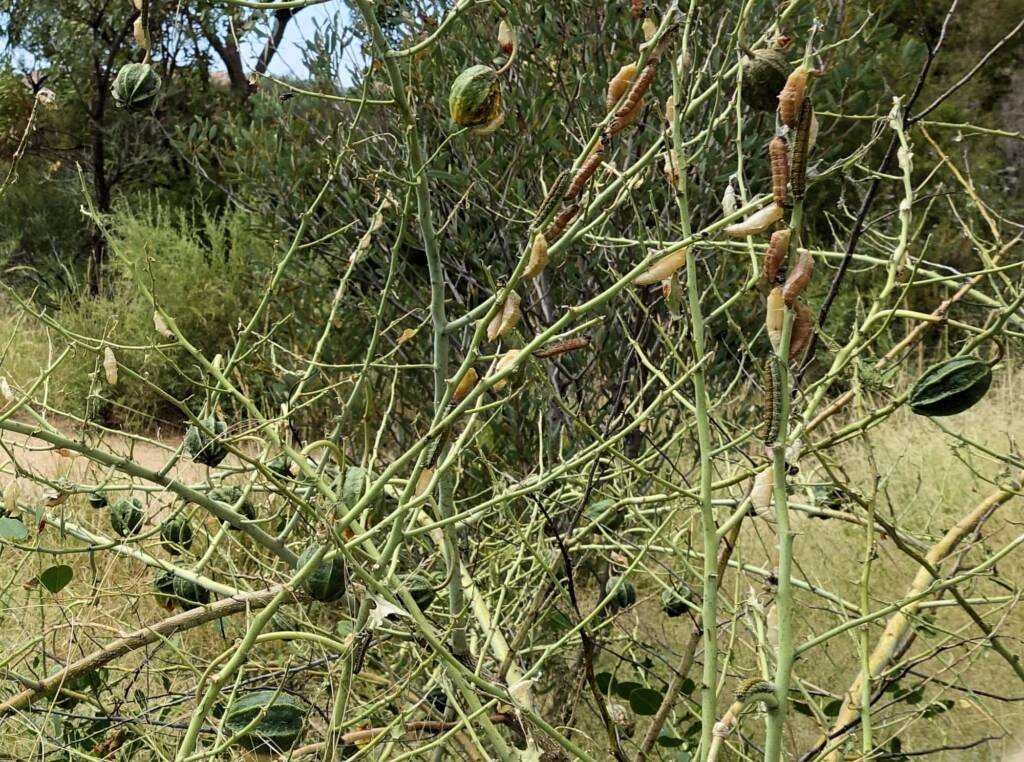
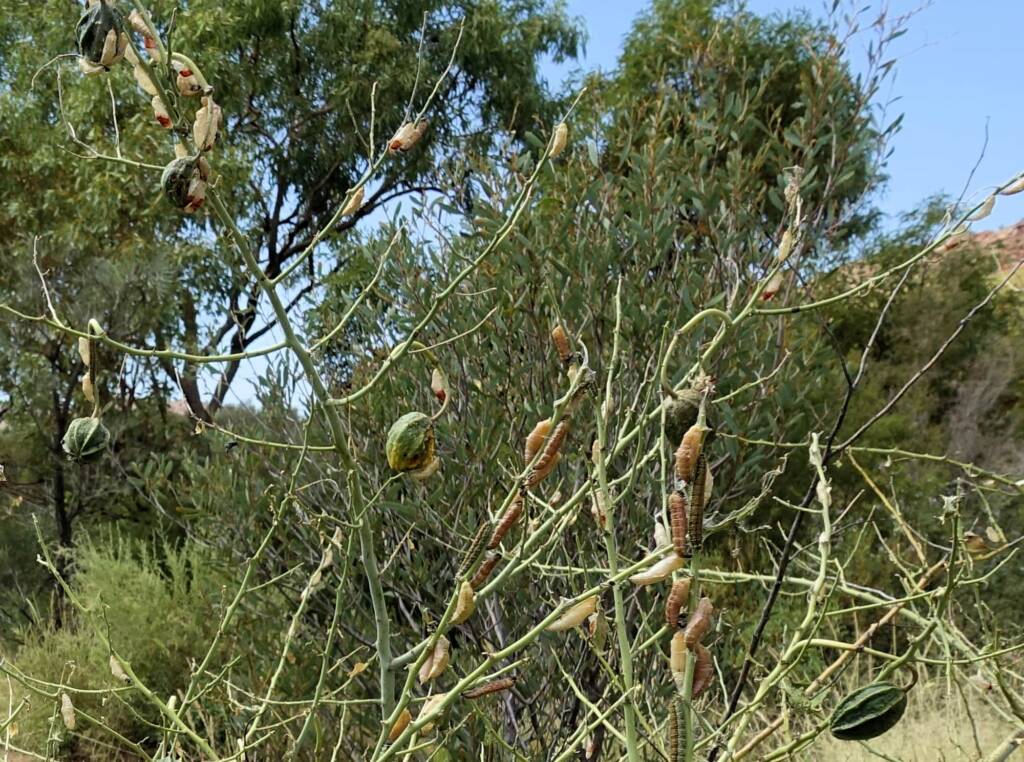
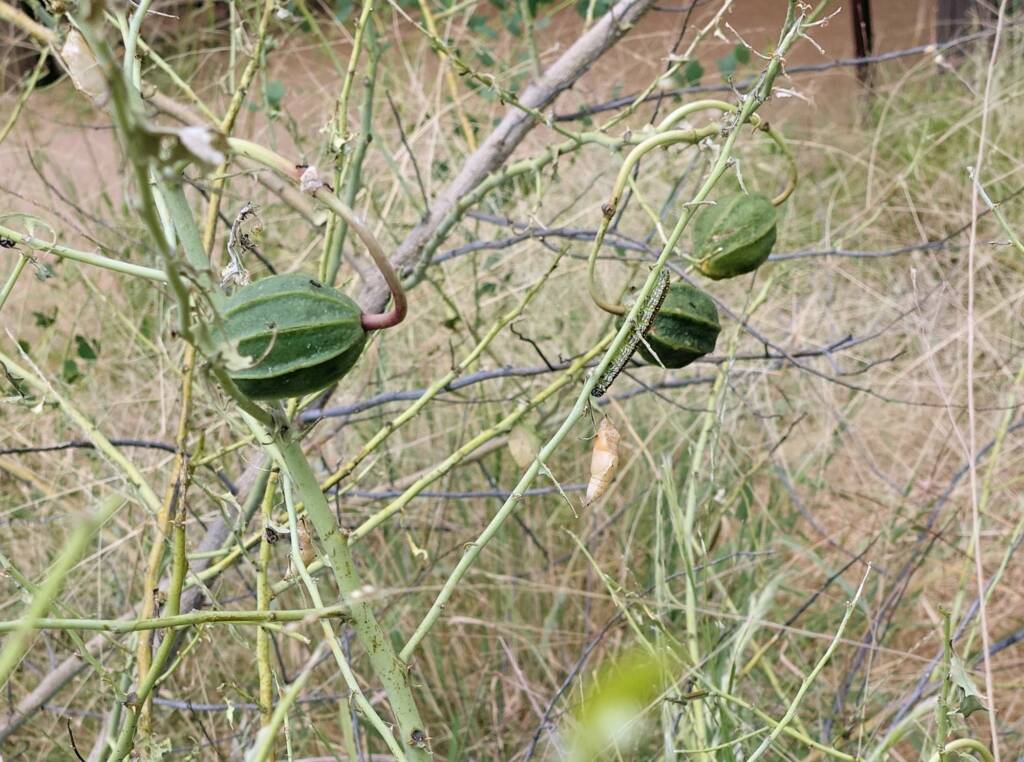
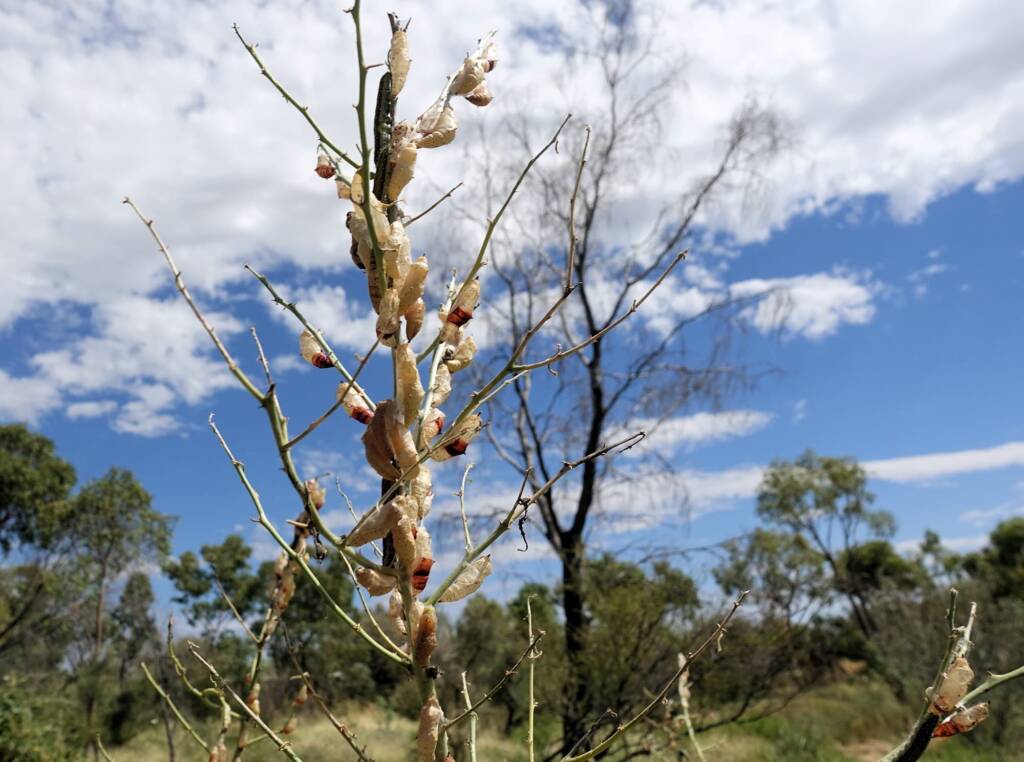
The caterpillars are different colours through their instars, from pale yellow to a dark brown to olive green, with white or yellow dots.
The adult butterfly are mainly white with black margins to their upper wings, with yellow-orange, black and white colours to the underwings. The markings can vary considerably from mainly dark to mainly white.
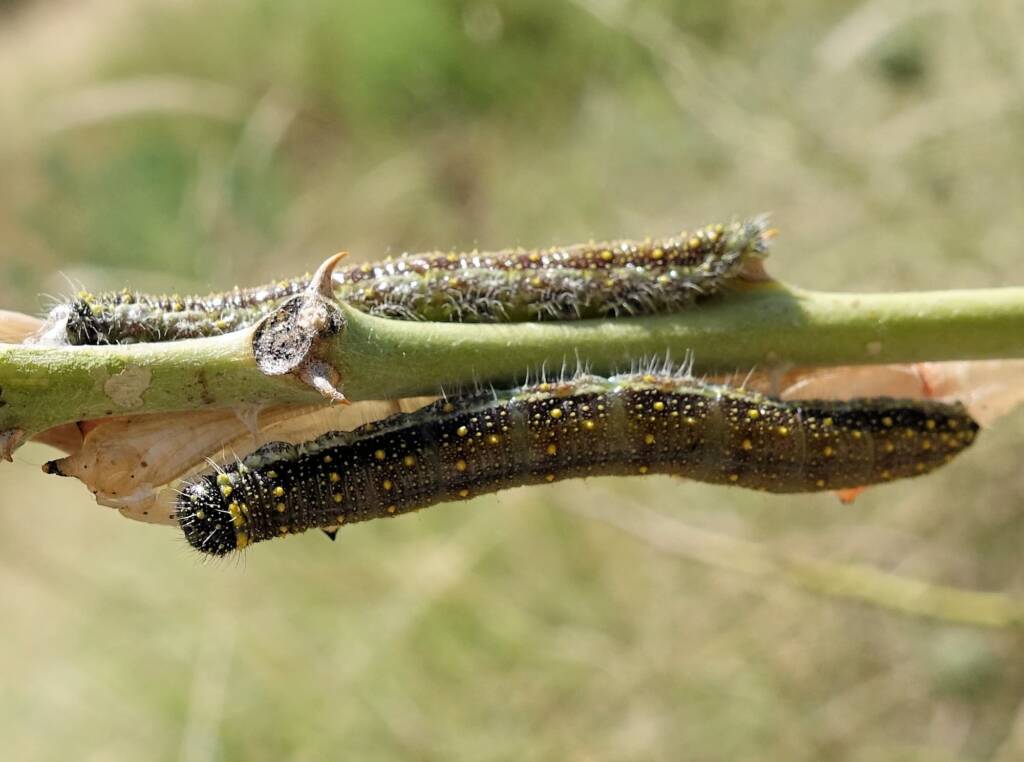
Many thanks to Cliff Meyer of the Butterflies, Moths and other Invertebrates of Australia, Facebook Group for explaining the different development and growth stages of the Caper White Butterfly.
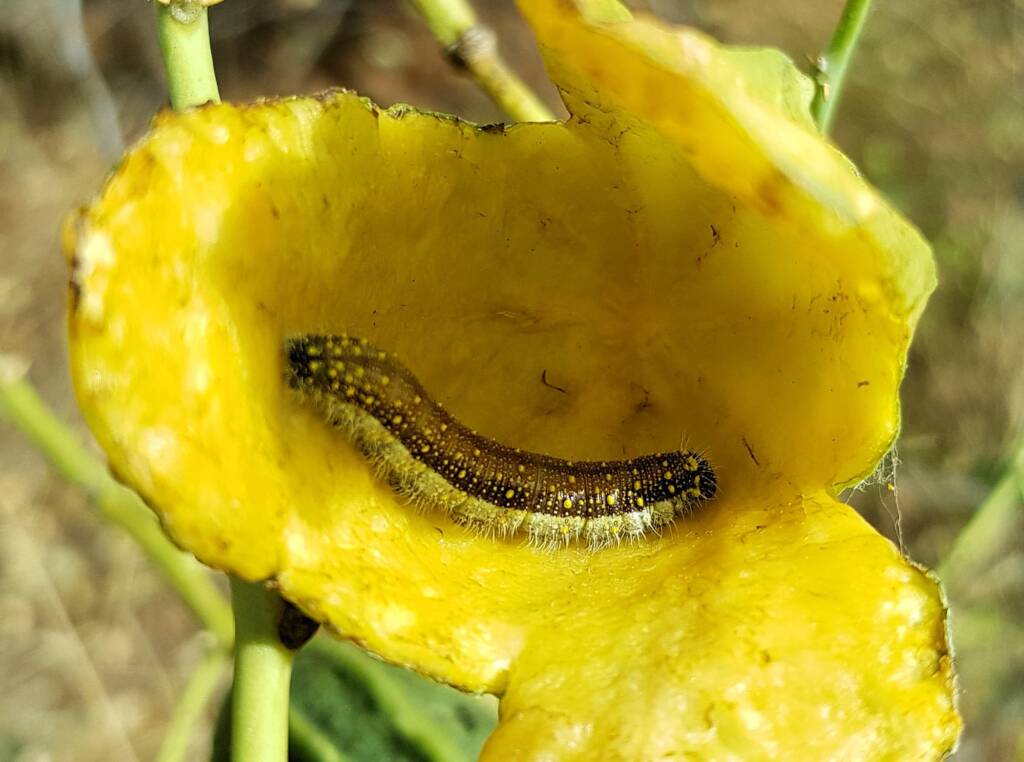
Following images of the flower of the Wild Passionfruit (also known as Caper Bush). Check out our page on the Wild Passionfruit (Capparis spinosa var. nummularia), including Olive Pink Botanic Garden Wild Passionfruit.
- Scientific classification
- Kingdom: Animalia
- Phylum: Arthropoda
- Class: Insecta
- Order: Lepidoptera
- Family: Pieridae
- Genus: Belenois
- Species: B. java
- Binomial name: Belenois java
- Subspecies:
- B. j. java (Indonesia)
- B. j. savuana (Savu)
- B. j. teutonia (Australia)
- B. j. ina (Indonesia)
- B. j. peristhene (Melanesia)
- B. j. picata (Melanesia)
- B. j. micronesia (Fiji)
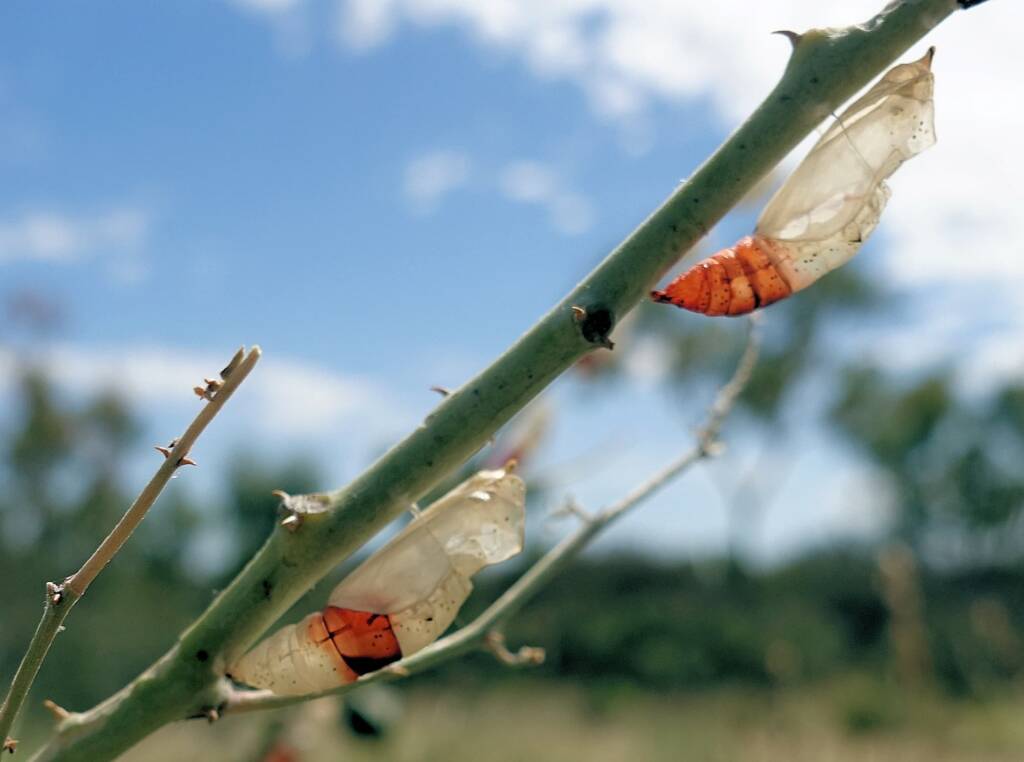
Footnote & References
- Many thanks to Cliff Meyer and Cory Dale for their input, member of the Butterflies, Moths and other Invertebrates of Australia, Facebook Group, https://www.facebook.com/groups/170745013686340/
Caper White ButterflyCaper White Butterfly & Caper Bush Caper White Caterpillar and Instar Eggs of the Caper White Butterfly Caper White Butterfly Metamorphosis
ButterfliesAcraea andromacha Caper White Butterfly Chequered Swallowtail Butterfly Common Eggfly Butterfly Meadow Argus Orchard Swallowtail Butterfly Yellow Palm Dart
InsectsBees Beetles Blattodea Butterflies Coleoptera Cicada Crabronidae Diptera Dragonflies & Damselflies Formicidae Hemiptera Heteroptera (True Bugs) Mango Planthopper Moths Orthoptera Orthopteroid Processionary Caterpillar Stink Bugs, Shield Bugs and Allies Syrphidae Wasps Water Scorpion (Laccotrephes tristis) Witchetty Grub

